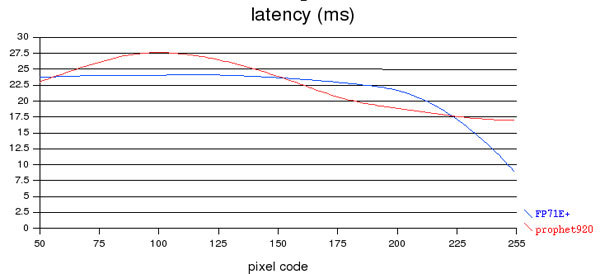BenQ's FP71e+ LCD Is Fast, But How Furious?
Latency: Hey! Where's My 8ms?
Now let's move on to what interests us gamers more than anything: latency! Here it is:
As you can see, the panel does indeed work miracles with sudden transitions. We measured 8.4ms in the best cases, which does make this monitor the fastest I've ever tested. The FP71E+ is even faster than the Prophetview 920 Pro (our reference monitor) 75% of the time. Between 155 and 220, the Prophetview 920 Pro does have the advantage. Also note that latency maintains a more or less constant value between 50 and 175, which is a plus in my opinion, since it means that all color shades have the same latency. As a concrete example, a yellowish object (R=175, V=175, B=90) on a black background will show a blue trail on a Prophetview 920 (the lowest color values have higher latency), whereas the trail will be grayish on an FP71E. It's less disagreeable.
But, the real question to ask is: Should a panel get a latency rating of 8ms if the actual latency value is really 20ms much of the time?
According to the ISO standard, the monitor's latency value is still 8ms, despite the variations during actual use. But you have to admit that the gap between what the user sees and what the standard dictates is widening into a gulf. When a 20ms panel measures at 28ms, the gap is 35% compared to the theoretical rating. But when an 8ms panel gets near 23ms and 24ms, that gap widens to 200% of the nominal value, which is absurd. This doesn't mean that the monitor is bad - it's not at all. But users have to be given a point of comparison that's representative of the use they make of the product. It makes you wonder what the real motivation is behind why the ISO standard for TFT monitor reactivity remains unchanged....
To get back to the monitor at hand, the AU Optronics 8ms panel is indeed extremely reactive, there's no doubt about that. Even if it measures at 24ms in the worst cases, it's still faster overall than the 20ms Hydis. And you can see it the see the difference.
The dispersion of the RGB channels is not aberrant; no comment to make in that department.
We should point out again that we measure latency on different channels to limit the width of the light spectrum sent to the sensor. That's because photodiodes, like the human eye, don't perceive colors like light blue, green and red with the same intensity. So, during tests, we avoid "mixing colors" in order to get the most accurate measurements possible. In addition, our method provides information on dispersion of pixels compared to the specified nominal latency.
Get Tom's Hardware's best news and in-depth reviews, straight to your inbox.
